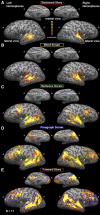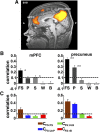Topographic mapping of a hierarchy of temporal receptive windows using a narrated story
- PMID: 21414912
- PMCID: PMC3089381
- DOI: 10.1523/JNEUROSCI.3684-10.2011
Topographic mapping of a hierarchy of temporal receptive windows using a narrated story
Abstract
Real-life activities, such as watching a movie or engaging in conversation, unfold over many minutes. In the course of such activities, the brain has to integrate information over multiple time scales. We recently proposed that the brain uses similar strategies for integrating information across space and over time. Drawing a parallel with spatial receptive fields, we defined the temporal receptive window (TRW) of a cortical microcircuit as the length of time before a response during which sensory information may affect that response. Our previous findings in the visual system are consistent with the hypothesis that TRWs become larger when moving from low-level sensory to high-level perceptual and cognitive areas. In this study, we mapped TRWs in auditory and language areas by measuring fMRI activity in subjects listening to a real-life story scrambled at the time scales of words, sentences, and paragraphs. Our results revealed a hierarchical topography of TRWs. In early auditory cortices (A1+), brain responses were driven mainly by the momentary incoming input and were similarly reliable across all scrambling conditions. In areas with an intermediate TRW, coherent information at the sentence time scale or longer was necessary to evoke reliable responses. At the apex of the TRW hierarchy, we found parietal and frontal areas that responded reliably only when intact paragraphs were heard in a meaningful sequence. These results suggest that the time scale of processing is a functional property that may provide a general organizing principle for the human cerebral cortex.
Figures








References
-
- Baddeley AD. Essentials of human memory. Hove, UK: Psychology; 1999.
-
- Benjamini Y, Hochberg Y. Controlling the false discovery rate: a practical and powerful approach to multiple testing. J Roy Statist Soc B. 1995;57:289–300.
-
- Benjamini Y, Yekutieli D. The control of the false discovery rate in multiple testing under dependency. Ann Statist. 2001;29:1165–1188.
-
- Brainard DG. The Psychophysics Toolbox. Spat Vis. 1997;10:433–436. - PubMed
Publication types
MeSH terms
Grants and funding
LinkOut - more resources
Full Text Sources
Miscellaneous
